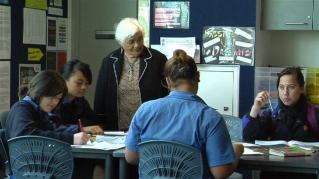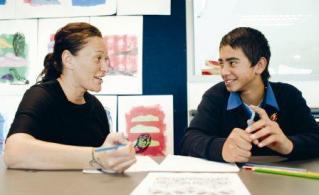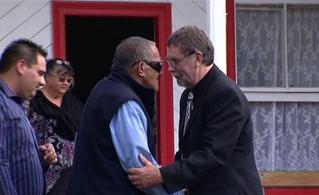Section navigation
At Henderson Intermediate, we see the beginnings of a successful push by Te Kauhua facilitators to engage whānau, by organising whānau hui, where data on Māori students’ attendance and achievement was shared. Thereafter, the whānau and the school took joint responsibility for Māori education in the school. They became part of the solution. As a result, the school community devised new and better ways of doing things. For example:
- At the recommendation of parents, a ‘buddy’ system was instigated for those students who had poor attendance.
- Teachers tried to be more overt with their feedback to students, in response to student requests for such transparency.
- The principal implemented a pilot for student-led conferencing, which dramatically increased parents’ attendance at teacher- parent interviews.
- Tuakana-teina relationships were used to raise levels of literacy.
- Teachers were trained as mentors – and modelled what they had learnt with their students.
The benefits of including whānau were evident. In fact, in the words of one facilitator, the school whānau ‘fixed issues that professionals couldn’t fix’.
At the core of these successful changes were relationships and expectations.
Questions / Things to think about / Activities
Relationships
1. Ka Hikitia, the Ministry's Māori education strategy, states that parents and whānau play a critical role in supporting their children's learning. How can we increase whānau involvement at our school, so that whānau are genuinely valued as partners?
2. What does whakawhanaungatanga (relationship-building) look/feel like in our classroom/school? How could we make whānau/iwi feel more comfortable?
3. What is our notion of ‘partnership’? What would a genuine partnership with whānau look like in our school, to show that we are mutually respectful and culturally responsive?
4. The Māori child is not an individual; s/he is part of a whānau, hapū and iwi. How can we show that we value these holistic foundations as we strive to build effective home-school relationships? How can we find out about students’ social and cultural backgrounds? Examples could include talking with students themselves or whānau, friends, and other teachers.
5. What evidence is there that shows what works for Māori students in terms of whānau engagement? (See pages 20, 32, 44, 47-49, 50 in Key evidence: Ka Hikitia about engaging parents.) How can we use this evidence in our school?
6. What kinds of discussion topics could be planned for a whānau hui? Example topics could include things that parents/ whānau want to see in our school; whānau /parent aspirations for their children's learning; kaupapa that parents would like to see included in the school curriculum.
7. What are some of the barriers we may need to overcome in setting up an effective home-school partnership? Examples are parents’ own negative experiences at school; teachers’ beliefs that school is their domain; time and energy involved; and the inability of teachers to plan work that has another world view/cultural lens. What strategies will we use to address these barriers?
Expectations
8. What evidence is there that shows what works for Māori students in terms of expectations? (See Key evidence: Ka Hikitia pages pp 32, 45 about teachers’ attitudinal shifts, and pp 10, 23, 32, 44 re teacher and parent expectations.) How can we use this evidence in our school?
9. Let's consider some of the stereotypes typically used to describe Māori students and their whānau/iwi. What expectations do we have of our Māori students – in terms of their capacity to learn and their behaviour? What are the expectations of their whānau? What are the Māori students’ own expectations? Is there symmetry/congruency across all three?
10. Are our expectations of Māori students sufficiently high for them to meet national curriculum goals? In what ways are these expectations the same as, or different from, expectations of other students? What influences our expectations?
11. Bishop et al (2003:204) note the potency of the self-fulfilling prophecy – where teachers’ low expectations of Māori students are not conducive to achievement. What actions can we take in our teaching practice, to address any ‘deficit theorising’? See Timperley and Phillips (2003:628) re the importance of having student learning goals, planning to address those goals, selecting appropriate tasks that align with those goals (and engage students), and implementing a planned programme to address those goals.
Leadership
12. In what ways is our senior leadership team made accountable for Māori student outcomes?
13. What are some of the things that Henderson Intermediate did differently, to bring about change? What could our school do differently to help realise Māori student potential?
Filed under: Productive partnerships | Ako | Effective teachers





